This is where Neil is able to answer your questions. However, to be considered, your question will need to be accompanied by a photograph. Send your question and photo to him here. He chooses those questions of greatest interest to our entire readership, so just to have warned you, plant ID questions rarely make the cut. Lots of great questions do, however, and here are his answers to those from this month.
Question: I’m getting tons of questions from anxious gardeners whose St. Augustine lawns appear to be dying, one quickly browned area after another. It’s a very common issue with lawns every fall. I have the answer for you.
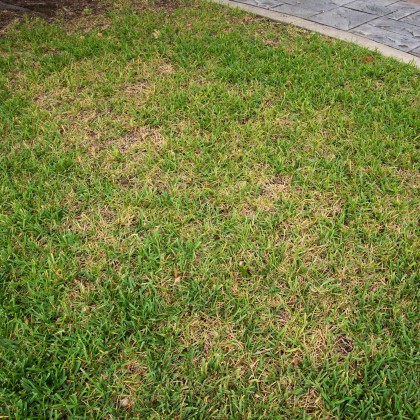
Brown patch is a cool-season fungal leaf disease that attacks St. Augustine from late September through November. It was a bit later this year due to the dry times of early fall.
Brown patch first appears as yellowed patches 18 to 24 inches in diameter. Within days, the blades within those patches turn entirely brown. When you pull on affected blades, they will come loose from the runners without resistance. You’ll see where they are decaying if you look closely at the ends where the blades attach to the runners.
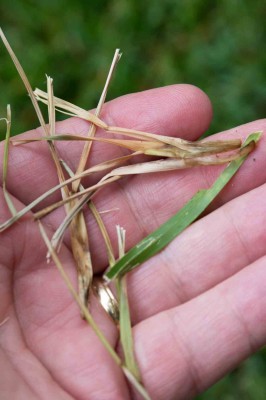
Closeup of Brown Patch
The fungus is spread by moisture. Do not irrigate in the evening (only in early mornings). Apply a labeled turf fungicide from your favorite nursery or hardware store at first signs of the disease.
While brown patch won’t kill the grass on its own, it weakens it enough that a bad winter could do unnecessary harm to the affected grass. By spring, all the grass will green back up uniformly. So if you have brown patch in your St. Augustine, you can at least begin to breathe once again. It isn’t as bad as you probably thought.
Question: I’ve been getting tons of questions about small twigs of cedar elms littering the ground for the past several weeks. Folks are rightfully concerned about their trees’ survival. Read Neil’s Answer
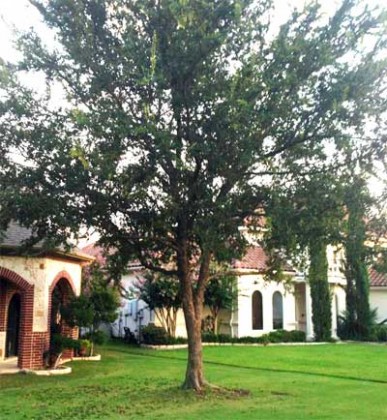
Obviously I’m not the only one getting calls about cedar elms dropping hundreds of 2- and 3-inch twigs to the lawn below. I even had a courtesy e-mail from my friend Russell Peters at Arborilogical Services in DFW (the only people I let touch my trees – www.arborilogical.com). Here’s what he wrote. (Thanks, Russ!)
Russell said they have been covered up with calls about cedar elms dropping small tips of branches. He says they’re seeing squirrels do this. (I had mentioned birds or squirrels in my Facebook posts.) He adds that you can fill up a trash bag of the twigs every day, and that it will go on for a short while longer. He ends by saying “It does not harm the tree at all.” In other words, no call to action. Great to have his confirmation.
Question: When and how do I plant seeds from my desert rose? J., no city given.
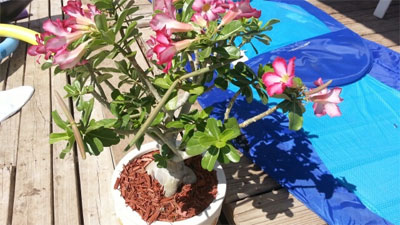
Nice job in growing this one! I’m going to be perfectly honest with you. I have not tried growing desert rose (Adenium) from seeds, but I did find several good sources of information online. Here is one example.
Question: Why are the leaves of my lacebark elm turning yellow? They’re scattered throughout the tree. It was planted two years ago. L.H., no city given.
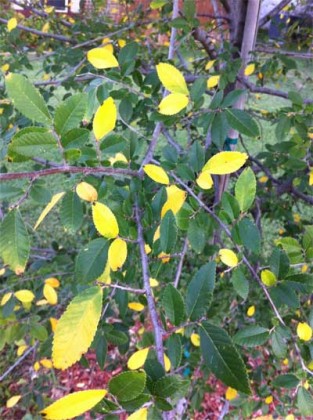
How unusual – the leaves are so intensely yellow. I would suspect that the tree probably got marginally too dry and is just shedding those leaves prematurely. It should rebound just fine next spring. I wouldn’t see any reason to take any type of action at this point.
Question: My yard was invaded by grasshoppers this year. I tried to spray, but they kept returning from adjacent property where the new owner apparently does not try to control them. What can I do to protect my plants? K., no city given.

You have done all that you can do. Grasshoppers are highly mobile, so unless you’re willing to stand out there spraying all day long every day, they’re going to reinvade your property each year. The hope you hold is that some years (perhaps 2013) are much worse than others. Maybe next year will be a light one. Hopefully your new neighbor will also start taking action.
Question: This wiry little weed has spread all over my yard. It is covered with tiny white flowers. How can I get rid of it? (Note from Neil: I’m getting this question repeatedly right now.)

Several of you have asked about this same weed. It’s called roadside aster, and it was the subject of a recent Garden Tip I posted on my Facebook page. Here is what I wrote:
“The weed is roadside aster. Wiry devil with fine foliage all summer, then these blooms in the fall. How it gets there: seed from weedy lots in the neighborhood; seed from other places in your own yard.
“The cure: take better care of your lawn. This weed will be the first to disappear when you start watering properly (with respect to our water curtailments), feeding regularly, and mowing at the recommended height on a regular basis. You could also apply broadleafed weedkiller (2,4-D) during the summer, before the plants start blooming. As for this year’s crop, hand-pulling is almost impossible. Use a sharp hoe to sever the taproot – much easier and a lot quicker.
“And to those who say, “I actually think it’s kinda pretty,” people who are trying to maintain attractive lawns won’t agree with you at all. To them (us), this weed is a bit like somebody throwing trash all over our yards.”
Question: We acquired some property in August. It had been vacant for 10 months or longer, and this young live oak is struggling. It’s sparse, and I see the crack on the south side of its trunk. Can it be saved? K.S., Farmersville.
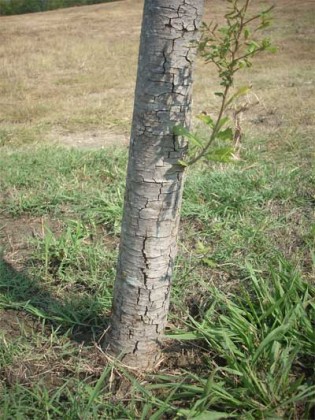
This is also sunscald, as with the maple above. It’s always a good plan, when planting a new oak, to protect its trunk with paper tree wrap from the nursery. That’s usually not as essential with live oaks as it is with Shumard red oaks and Chinese pistachios, but it certainly would have helped in this case. I would suggest cleaning the wound up with paint thinner and a rag, then wrapping the trunk. Unwrap it every couple of months to check on its progress in healing. You may be wondering what to do with the sprout on the right of the trunk. If this were my tree, I would wrap around it and leave it in place for a few months. If it appears that the top growth might be dying because of all this damage, this new sprout might need to become your new trunk. You might have to cut the top back to a point just above that shoot in a year or two, or the top might recover completely, at which time you could simply clip off this shoot. And finally, completely as a side note, I am trying to figure out some angles from your photograph. It looks like the tree leans to the right. It looks like the horizon (the ground) slopes way to the left. Is the tree that far out of plumb? That’s a different issue that would, if true, cause concern for the tree.
Question: Our dwarf wax myrtle bushes are 12 years old. They have thrived until last year. We replanted one, and now the adjoining bush is dying. We’re in the Blackland Prairie clay soils. J., Lake Lavon area.
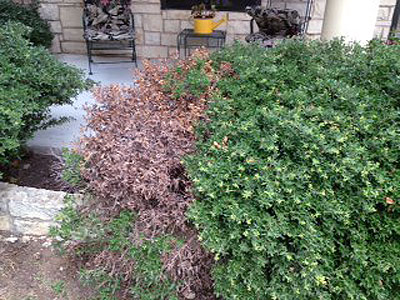
It’s been my observation for the past 20 years that wax myrtles and dwarf wax myrtles have very short life expectancies in alkaline soils around DFW. This type of limb die-out is exactly how they operate, and I don’t believe there is any disease involved. They just don’t handle the alkaline soils and low humidity very well. They’re better suited to areas much farther south and east of the Metroplex. To be completely honest, I can’t see your photo very well. The shrubs in question look to my eye to be more like dwarf yaupon hollies than they do like dwarf wax myrtles. But I’ve left my answer based on your identification. Just felt that I needed to mention that.
Question: My coral bark maple struggles in too much sun. Because of a lack of shaded space, I endure it. It gets burn on the edges of its leaves, and now I see that the trunk is cracking and oozing. What can I do? J.J., Parker County.
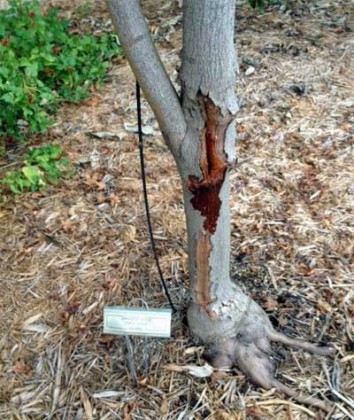
Coral bark maples are forms of Japanese maples, and just as in the answer above, your tree needs to be given a lot more protection. This crack really concerns me, as it may be due to sunscald. Clean up any active decay, but do move the tree if you possibly can, even if that means giving it to a friend. I have a coral bark maple that gets no direct sunlight, yet mine scorches somewhat just due to heat.
Question: The nursery tag for my Japanese maple said it could grow in full sun. However, it has really struggled and has only recently begun to put on new leaves. Should I transplant it to a shady spot this winter or leave it alone to get established? No name given, Corsicana.
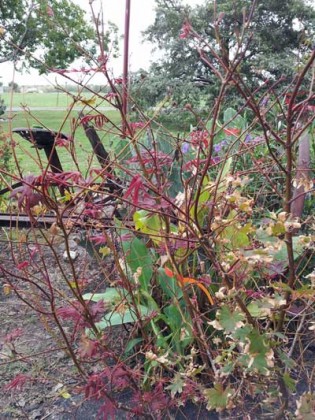
That label was written for the Pacific Northwest — or somewhere else, just not for Texas. Japanese maples must have full shade against the Texas summer sun. I can still see leaf scorch on the lower green leaves that remain on the tree. Move it to the shade this winter!
Question: I have used a broadleafed weedkiller to try to get rid of this weed all season long. I still have it. What can I do? (Note from Neil: Several readers asked similar questions.)

This is sheep sorrel. It’s a weedy form of oxalis, and it’s really tenacious. I would continue to use the broadleafed weedkiller. We have no product that is any better for oxalis. However, I’d offer these suggestions. First, include one drop of liquid dishwashing detergent with each gallon of spray that you mix. That will hold the spray on the waxy leaf surfaces. Use a pump sprayer and not a hose-end sprayer. You’ll be able to apply smaller droplets that way, and again, they will hold onto the leaves better. Do not spray before or right after you mow your lawn. You need as much leaf surface as possible to absorb the 2,4-D broadleafed weedkiller.
Question: My fruitless mulberry tree has a dead limb (red dot). I’d like to prune it out, but I see dark discoloration where the dead branch has been growing together with a living branch. How should I prune it, and should I wait until winter? T.N., Marfa.
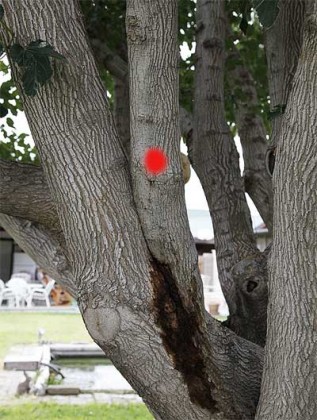
There is active decay where moisture has been seeping in. That causes the discoloration, and it looks like the decay may have moved into the living branch at its base as well. Further, the branch in the back that appears to be coming off at an odd angle seems like another problem. I would suggest using a small hand pruning saw to remove the dead branch carefully. Once you have it out of the way, you’ll be able to determine the health of the remaining larger branch. You can do this type of pruning now if you wish. I just hope the decay hasn’t moved into the healthy branch. The troubles probably began where the two branches pinched together and trapped moisture and debris. The same thing happens to Bradford pears. Good luck with it!
Question: This holly tree is at the entrance to a home we have just bought. Why would some of its branches be dying? M.O., Southlake.
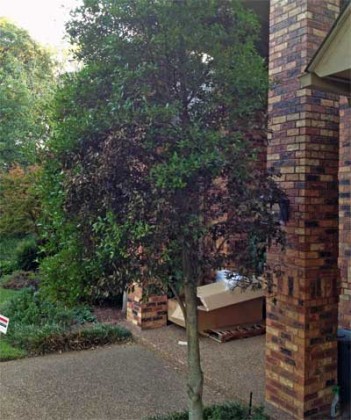
It’s difficult to tell, but I would definitely rule out insects and diseases as possible causes. It looks much more like a tree that has gotten marginally too dry over the past summer. Sometimes, if one side of a plant gets too dry due to irrigation issues, branches on that same side will suffer. I just can’t see anything else.















